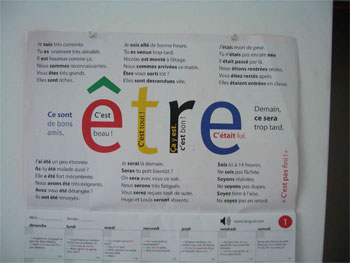Continuing the series of lessons derived from the wall chart learning tool, I want to revisit a common use of the key French verb être in a construction that can be difficult for learners to understand.
The construction “ce” + “être” in the calendar
This most important construction is made up of the pronoun ce and the verb être, producing, in its most common form: c’est “it/this/that is.”
Readers who are using my Essential French wall chart calendar will notice that right in the center of the top page devoted to être there are eight examples of various tenses and uses of this construction.
And the top row of the examples on the bottom page contains seven more examples. When designing the calendar, I felt that this construction was so important that it had to occupy a prominent place where users will be constantly reminded of its use.
If you already speak French, you are probably already using it without even thinking about it. I have drawn attention to it in my post on using the real-life examples.
The different forms of “ce” + “être”
The one form that is more common than all the others combined is c’est. Using the conjugated forms of être, the other relatively common forms are c’était “it was”, ce sera “it will be,” ç’a été “it has been / it was” and ce va être “it is going to be”. There is also the present subjunctive que ce soit,
There are two plural forms: ce sont “they are” and c’étaient “they were.”
Here are the negative forms: ce n’est pas, ce ne sont pas, ce n’étaient pas, ce ne sera pas, ce n’a pas été and ce ne va pas être. Note that in spoken French the negative marker ne or n’ often disappears.
There are other somewhat exotic and rare forms that you need not really worry about unless you have a special need.
Nearly all of my examples will be with c’est because it so important, but keep in mind that the other forms could be used as well.
Using “c’est”
Somewhat like the “it” of “it is,” the pronoun ce in c’est often refers to some object, person, event or idea that has been mentioned previously. This can very specific, quite vague or even non-existent. Then with est we connect the ce to something else.
So, learning to use c’est properly boils down to learning what can go in front and/or after.
I’ve identified about 10 different ways that one can use this construction. To keep this blog post down to a manageable length, I’ve decided to look at what I consider the three most important ones.
Use 1: “c’est” + adjective
This is probably the most common form and something that you are already using. Basically, you can put any adjective or adjective-like word after c’est. Here is what it looks like:
Cest + beau, bon, facile, difficile, bien, sympa, magnifique, ridicule, cher, possible, impossible, cher, bon marché, tout, faux, vrai, faux, grave, etc.
You’ve certainly heard and probably used c’est bon “it’s good,” c’est beau “it’s pretty,” ce n’est pas grave “it’s not serious” and c’est vrai “it’s true.” You can insert adverbs to make things like c’est très bon or c’était vraiment beau.
Notice that the adjective is always in the masculine form regardless of the grammatical gender of the noun to which ce may refer to.
I used this construction just the other day when I was walking down the street and saw a pretty garden being watered by the gardener. Here is the exchange.
– Ah c’est beau, c’est beau, c’est vraiment très beau.
– Merci.
Notice how I used that repetition typical of spoken French, something that you would rarely see in written French. The ce or c’ here, of course, refers to the garden that is not mentioned at all but is clearly understood by the two people.
A note on “c’est bon,” “c’est beau” and “c’est bien”
Note that these forms, in addition to having their specific meanings, are often used interchangeably to mean “it’s OK,” “fine,”good.” Here is something I overheard in a medical clinic where someone was asking for an appointment:
– Je peux vous donner le 18 septembre à 10 h. C’est bon ?
– C’est bien. D’accord.
– C’est beau, alors on vous attend le 18 septembre à 10 h.
– C’est bon. Merci beaucoup.
USE 2: “c’est” + noun or pronoun
This use is similar to Use 1 but with a noun in place of the adjective. Here are some examples:
C’est la vie.
C’est l’enfer.
C’est une voiture.
C’est la maison.
This is straightforward and I won’t spend any time on it. This construction is commonly used to make complex sentences such as:
Vous savez, c’est la vie moderne. “You know, such is life today.”
C’est l’enfer vivre dans ce quartier. “Living in this neighbourhood is hell.”
C’est une voiture qu’elle aime beaucoup. “It’s is a car she likes a lot.”
C’est la maison dont je t’ai parlé. “This is the house I spoke to you about.”
C’est une bonne question. “That’s a good question.”
Of course, you can combine Use 1 and Use 2 to create constructions like:
C’est beau la vie. “Life is beautiful.”
C’est ça la solution. “That’s the solution.”
C’est pas cher la voiture. The car is not expensive.”
Use 3: noun, “c’est” +..
So far the uses of c’est are pretty much parallel to the English “it’s.” The next big category of uses is more challenging because it is quite different from English. Let’s start with a phrase attributed to king Louis XIVIII:
Le roi, c’est moi “I’m the king”
The French is translated literally as “The king, it is me.” Let’s look at the various things the king could have said:
3.1: Je suis le roi
3.2: C’est moi le roi
3.3: Le roi, c’est moi
They all mean the same thing but are they interchangeable? 3.2 and 3.3 are somewhat interchangeable because they both emphasize le roi. 3.1 is a simple statement of fact. I think that 3.3 is the strongest.
This sort of construction is very common in French because it highlights the subject. Here are a few examples:
Une réputation, c’est vite démoli. “A reputation is quickly demolished”
La recherche, c’est important. “Research is important”
La question, c’est quand. “The question is when.”
La bonne nouvelle, c’est qu’il n’y a pas de grève. “The good news is that there is no strike.”
Le problème, c’est qu’on est en retard. “The problem is that we are late.”
Conclusion : Keep your ears open for “c’est”
I can’t emphasize enough how important it is to master the use of c’est. It’s really huge in spoken French and you will hear it constantly in the real-life examples on this site.
The good news is that you are probably using the easy forms already. But do look out for what I’ve called Use 3.
The bad news is that there are a number of complications and subtleties that I will come back to in future posts. For the time being, the essential elements are here and on the wall chart calendar.
Stanley Aléong is a polyglot, author, musician and language coach in French, English and Spanish. He likes to share his passion for languages and believes that anybody can learn to speak a foreign language well with the right methods and tools. He has also invented a cool visual learning tool called the Essential French Wall Chart Calendar. Reach him at info@langcal.com.



